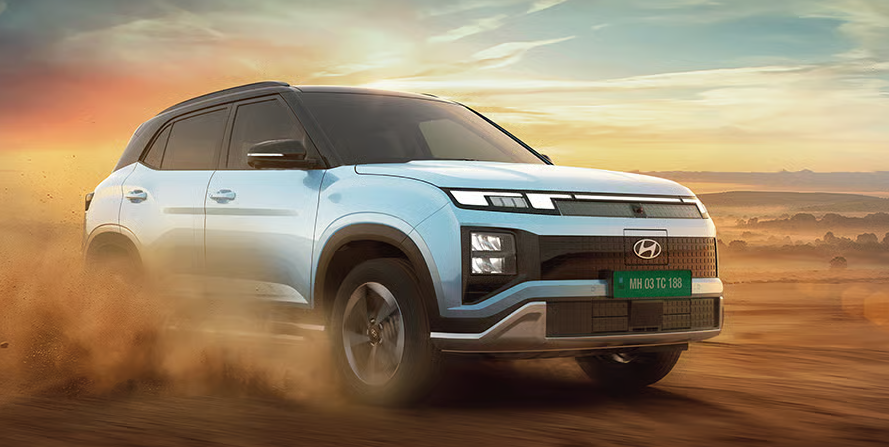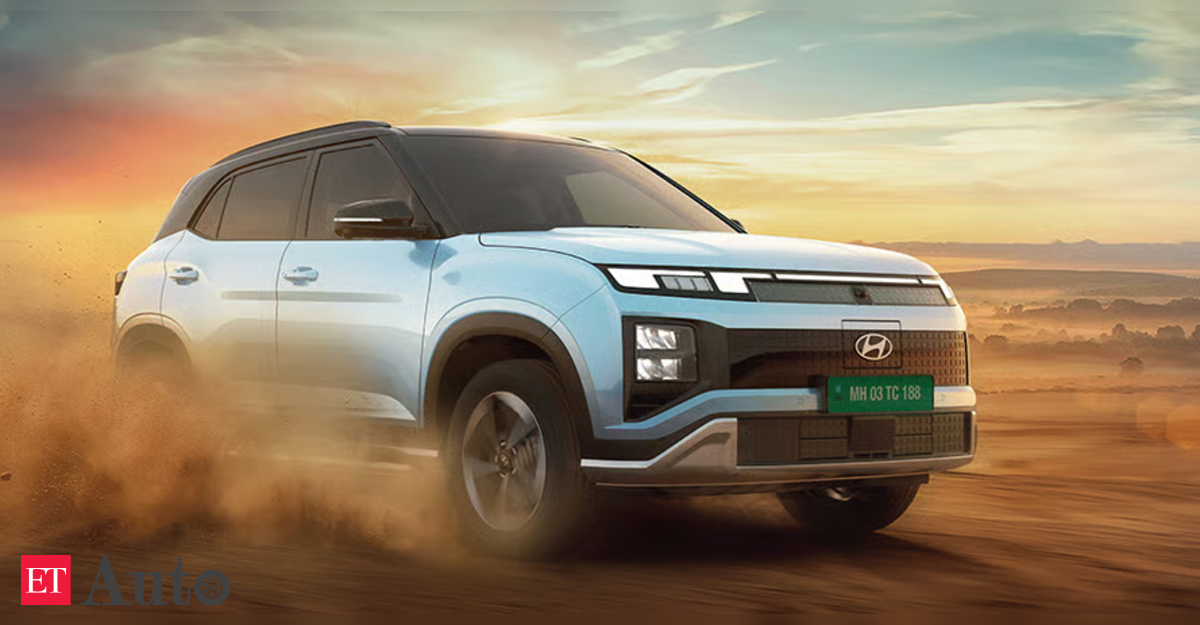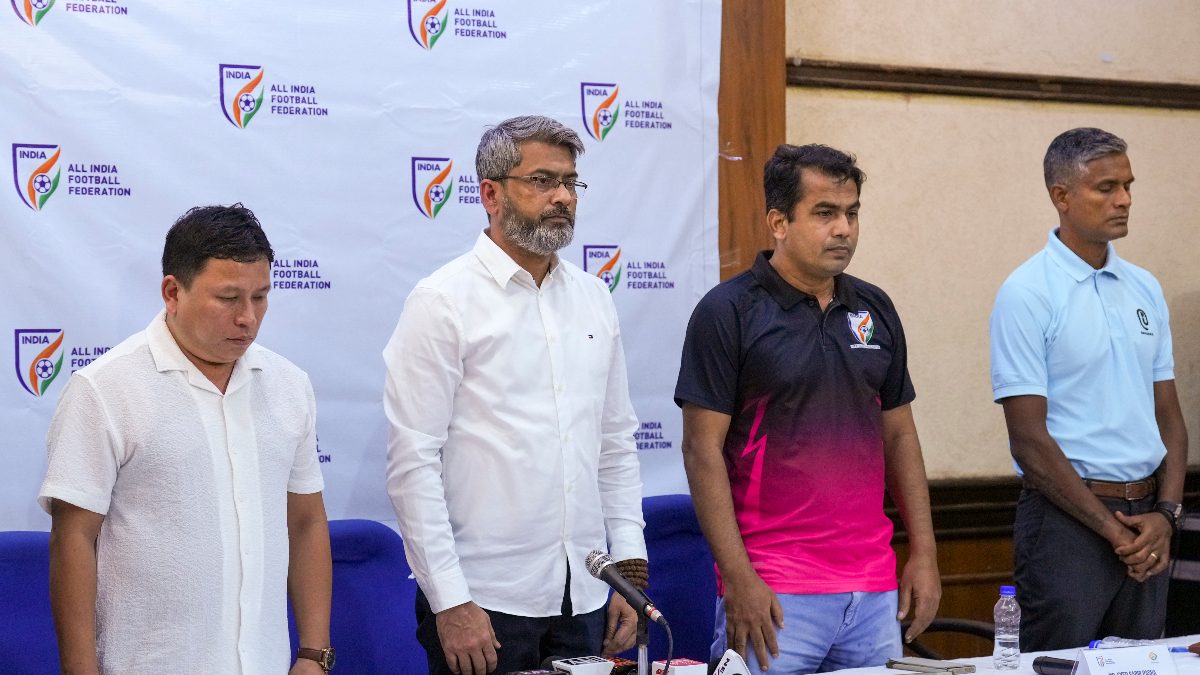 Hyundai Creta EV
Hyundai Creta EVThe passenger vehicle market witnessed a mini reshuffle among top OEMs in September, with Hyundai Motor India coming in fourth in domestic sales, behind Tata Motors and Mahindra & Mahindra.
This is at least the second such instance in FY26 when Hyundai has lost the overall second position (behind Maruti Suzuki India) in the PV pecking order as competitors have raced ahead.
While a month or two of market share decline would not normally be an indicator of any long term slippage for most OEMs, the continuous rise in competitive intensity from Tata and M&M has led to questions about Hyundai eventually retaining the second spot in overall domestic sales.
The two aggressors have built a vibrant electric vehicle (EV) portfolio and have been able to capture increasing shares in the budget conscious segments, semi-urban and rural pockets, as well as SUVs whereas Hyundai is seen as being overdependent on a single model (Creta) and caught in the premium portfolio trap.
According to data compiled by brokerage ICICI Direct, Tata Motors reported almost 50 per cent year-on-year (YoY) growth in domestic wholesale numbers for PVs in September while M&M reported nearly 43 per cent growth in utility vehicle (UV) sales. Hyundai’s domestic sales growth was not even a per cent over this 12 month period.
Tata’s EV portfolio — led by the Nexon EV, Tiago EV, and Punch EV — has gained significant traction, with the Nexon EV emerging as one of the top-selling modelsRamnath E
So is Hyundai’s second position in PVs under threat?
Brokerage HDFC Securities has used data from the Society of Indian Automobile Manufacturers (SIAM) and its own research to say that “The company’s No.2 position (on an annual basis) in the domestic passenger vehicle market is under threat, with key competitors for the position, M&M and Tata Motors closing in with a popular and balanced portfolio”.
Analysts Hitesh Thakurani and Shubhangi Kejriwal said one of the reasons for the slide in Hyundai’s market share has been the increased aggression from Tata and M&M which have a “popular and balanced” portfolio.
The early lead that Tata Motors, for example, has taken with its EV portfolio appears to be working to its advantage. And to Hyundai’s disadvantage, since the company has a limited offering of electrics.
Ramnath E, Team Lead at mobility advisory MarketsandMarkets said that Tata Motors has established a strong, early lead in the EV space with electric models accounting for nearly 13–15 per cent of total sales in September 2025. He said this trend is likely to continue into October too.
“Tata’s EV portfolio — led by the Nexon EV, Tiago EV, and Punch EV — has gained significant traction, with the Nexon EV emerging as one of the top-selling models. The upcoming Harrier EV is expected to intensify competition even further, making it difficult for Hyundai to hold its ground unless it strengthens its own EV lineup,” he said.
Ramnath said that Hyundai’s EV strategy in India remains limited to premium, high-priced models like the Ioniq 5, Kona and the recently introduced Creta EV. “With little presence in the mass-market EV segment, Hyundai is losing out where adoption is accelerating the fastest. This clear gap in product positioning has allowed Tata to dominate the mass EV adoption game, securing an advantage in the segment that is driving the bulk of growth.”
In the case of M&M, the strengthened SUV portfolio with XUV700, the Thar and ScorpioN is helping boost sales.
Puneet Gupta, Director at S&P Global, said that to some extent, Hyundai “has been missing in action in the midsize segment and new fuel technologies like hybrids and EVs” but also pointed out that Hyundai is already gearing up for an aggressive, five-year plan with multiple launches across models and fuel types. “Together, Hyundai and Kia (sister brand) aim to shift the orbit under their bold strategy ‘repivot India’,” Gupta said.
Hyundai has been missing in action in the midsize segment and new fuel technologies like hybrids and EVsPuneet Gupta
Overdependence on Creta
Meanwhile, Thakurani and Kejriwal underlined Hyundai’s overdependence on a single though successful model, Creta, which accounts for more than a fourth of the company’s overall volume mix. “The company’s key and best-selling vehicle has been the Creta.
However, the concentration risk from the same has gone up over the last decade. Creta now forms 32.6 per cent of the domestic volume mix and 26.1 per cent of the overall volume mix, while the revenue mix and EBITDA mix, we believe, would be even higher. We expect this to be more diversified in the medium term as the company launches new models, and as competition in the Creta segment heats up, like we have seen recently with MSIL’s (Maruti Suzuki India) launch of the Victoris,” they said. The HDFC analysts said they expect limited growth in Creta volumes going forward.
Also Read: Tata Motors zooms past Mahindra to claim No. 2 spot in September sales
New launches, stronger EV portfolio
A Hyundai India spokesperson declined to comment when asked about the reasons for decline in market share. But the company had earlier announced plans to launch 26 new products in India by the turn of the decade, of which six will be electric vehicles.
And at the South Korean parent company’s investor day last month, it was announced that India will get its first locally made electric vehicle by 2030. There is also some talk of launching strong hybrid variants of existing models and the Creta is expected to get a major upgrade in two years with multiple powertrain options.
Also Read: September sees record auto sales with GST cuts boosting customer sentiment
Hyundai already has a winner in Exter, positioned at the entry-level of the SUV segment and competing with Tata Punch. The Exter should get a fillip with the recent GST rate cuts and help customers looking to upgrade from small cars into the SUV segment. But unless Hyundai gets a much stronger EV portfolio and more models to target the price conscious customers in India’s hinterland, the risk of losing its second position in the overall PV pecking order may remain.



)
